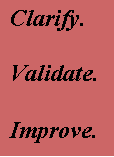 Synergia delivers methods and
technologies that explicitly focus on coordination. Operational
complexity is reduced, and institutional and accreditation mandates are more effectively assimilated
- all because the management aspect of healthcare delivery is vastly clarified and simplified. Best
of all, practitioners do more of what they set out to do - focus on the clinical situation and
healing the patient.
Synergia delivers methods and
technologies that explicitly focus on coordination. Operational
complexity is reduced, and institutional and accreditation mandates are more effectively assimilated
- all because the management aspect of healthcare delivery is vastly clarified and simplified. Best
of all, practitioners do more of what they set out to do - focus on the clinical situation and
healing the patient.
Synergia’s methods and technologies rest on a foundational theory of human systems, called
Generative Practice Theory (GPT), which we developed while at Stanford University. GPT is a validated
theory of individual and social thought and action; we have tested it in dozens of applications. GPT
focuses on the practices of participants in an organization or other social system. Practices can be
thought of as skills or habits - they are capacities to produce and adapt behavior in a range of
situations, and toward valued ends.
Synergia conducts its work for clients using a method called Critical Practice ManagementTM
(CPM). In CPM, we develop and validate maps of the practices of organizational participants - individuals,
teams, formal groups such as departments or divisions, or even the organization as a whole. We carefully
map not only the individual skills/practices of individuals, but also the way those skills depend on the
skills of others. From this we develop precise maps of the roles played in the organization. Ultimately,
the organization is defined by the pattern of its practices, structured into roles. We have been very
successful in developing human-systems models,
identifying and
quantifying risks, designing interventions, and forecasting actor behavior under changing conditions.
 CPM is critical in two senses: we guide mapping to test and validate any conclusions, and we direct all of
our effort toward the betterment of the organization. These two aspects of criticality support one another,
because we develop and validate what is, in part by helping the organization to articulate what would be
better. By investigating the contrast between what is and what might be brought into being, we clarify what
is as well as foster what is better. This approach naturally reveals barriers to change, while at the same
time creating the type of participation necessary to address those barriers.
CPM is critical in two senses: we guide mapping to test and validate any conclusions, and we direct all of
our effort toward the betterment of the organization. These two aspects of criticality support one another,
because we develop and validate what is, in part by helping the organization to articulate what would be
better. By investigating the contrast between what is and what might be brought into being, we clarify what
is as well as foster what is better. This approach naturally reveals barriers to change, while at the same
time creating the type of participation necessary to address those barriers.